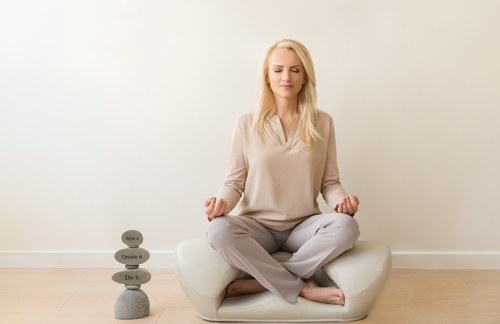
Is meditation the wave of the future in education?
Our children’s brains are where 89 billion neurons fire in an organized way. It’s their control center. But in an increasingly warp-speed, hyper-linked world where social media competes for our children’s waning attention spans, while school shootings and bullying compound their already heightened classroom stress, students’ brains are overtaxed.
Could simple meditation be the answer?
In San Francisco, schools participating in Quiet Time, a transcendental meditation program, had twice the number of students score proficient in English on the California Achievement Test than in similar schools where the program did not exist.
Numerous other studies on meditation in schools show everything from improved self-control, focus, test scores and kindness toward others, to lessening depression, anxiety and ADHD symptoms. So why isn’t meditation implemented in Orange County classrooms?
“Well, now that the OC has gone blue, that might change,” says Bob Roth, CEO of the David Lynch Foundation, which brings Quiet Time into schools across the country at no cost. Roth is referring to recent elections, of course. But regardless of where you stand politically, the science is persuasive.
“The research is clear about neuroplasticity and our ability to affect and change the brain, its ability to self-regulate and organize thoughts and to a large extent attitudes and feelings from negative to positive,” says Orange County Superintendent of Schools (for the last six years) Al Mijares. “And Quiet Time to the extent that it’s contemplative reflection is great. But the word ‘meditation’ implies an Eastern religion. Many parents don’t want their children indoctrinated into any religion. They believe introducing religion into their child’s life is their job.”
Is Meditation Spiritual?
A Harvard study published in the November 2018 issue of the American Journal of Epidemiology seems to equate the two, saying that spiritual practices in childhood are good for health and wellbeing, showing that people who were engaged in “meditation or prayer” in their childhood and teenage years reported better on scores of wellbeing, greater life satisfaction and self-esteem. But is meditation prayer? Or are we conflating the two?
“Meditation is simply a medical intervention that is science-based,” says Roth. “The stress today is crushing children. Suicide is now the No. 2 cause of death in teens with the fastest growing rate in girls 13 to 16. Every child should have access to a proven technique that’s been proven in studies to work.”
Quiet Time is done on a voluntary basis and it’s available in and around the country including school districts in California like Los Angeles and San Francisco. For children in grade school, it’s 10 minutes in the morning and 10 minutes at the end of the day.
“It’s important that children know that silence is valuable,” says Roth.
Sharon Salzberg, co-founder of the Insight Meditation Society in Massachusetts echoes Ross’ sentiments, reporting that mindfulness meditation has now become a widely prescribed therapy for many conditions, including ADHD.
Meditation uses the mind to quiet the mind, creating a relaxed state of alertness, which makes learning and focusing much easier. While many parents like the idea, they wonder if their child is too young to meditate.
“Most children are not ready to sit still and concentrate until age 7 or 8,” says Lionela Torriero, of Laguna Beach, who has been teaching meditation for years. “I start a very young child at one or two minutes, first teaching them to breathe properly by having them place one hand on their diaphragm and one hand on their forehead. Then I ask them to visualize a light going up and down so they feel the energy moving. It’s very relaxing.”
Louise Allison, a full-time family meditation teacher for 40 years with offices in Newport Beach and Laguna Beach, knows that meditation is a great tool for children growing up in a world that’s so competitive. “l see 10-year-olds who are so stressed,” she says. “We will work toward 10 minutes for a 10-year-old and then I have them increase that by one minute each year on their birthday.”
Roth, who began meditating while at Berkeley in the late ’60s and is the author of the new book, “Strength In Stillness” describes meditation as “going deep within.”
“The mind can be like the ocean, very tumultuous and turbulent on the surface. But when you go deep down, there is complete calm,” says Roth.
Mijares agrees that calm in the classroom is key to teaching and learning.
“We think school is just about the core subjects, but there are also the meta-cognitive skills which help students manage,” says Mijares, who thinks that contemplation in the classroom would be beneficial. After all, if there are 30 students to a class and two of those students are taking up a great deal of the teacher’s time and attention, that doesn’t seem fair to the other 28 students.
“But the concept of Quiet Time would first need to be understood by the parents who could then bring it up at a board meeting,” Mijares adds.
Meditation Over Medication
“I think meditation would be great in schools. It would help students to self-regulate,” says Laguna Beach resident Georgianna Spirtos, who has a doctorate in education and works for Cal State Teach as a teacher-educator. She is also the mother of three children ages 10 through 18, the youngest of whom takes medication for ADD.
“If my daughter could learn to meditate in order to calm and focus herself it could be a lifelong practice without the side effects of medicine,” says Spirtos.
Moreover, it’s a lifelong practice with exponential benefits.
A 2011 brain imaging study at Yale University showed that people who meditate regularly are able to switch off parts of the brain associated with anxiety, schizophrenia, ADHD and other problems. The researchers used functional magnetic resonance imaging to scan the brains of beginner and experienced meditators. They found that experienced meditators exhibited less activity in an area known as the “default mode network,” which is linked to self-centered thoughts. They concluded that experienced meditators may have developed a new default mode based on being mindful of the present rather than focused on the future or the past.
There’s No Place Like Om
In order to become experienced at anything, it takes practice. We must all start somewhere.
“I have clients who’ve read about the benefits of meditation for ADD and they’ll come and want me to teach their children meditation,” says Torriero, “I tell them they should be practicing themselves at home so their children can see them doing it.”
While it may not be easy at first, meditation is simple and the research shows that by engaging the brain in this discipline, the benefits to the mind and body can be profound and far-reaching. Our children live with stressors we never dreamt of—it’s our responsibility to help them adapt.
“Across the country, 17 kids are dying every day from opioid overdose,” says Roth. “We’ve got to do something.”
By Joni Ravenna

Free Falun Dafa Meditation Classes
Fountain Valley
Mile Square Park, 16801 Euclid St. Fountain Valley
714-401-7373
Sunday 8am~10am
Irvine
Heritage Park, 4601 Walnut Ave. Irvine
949-387-3188
Saturday & Sunday 7:50am-10am
Info: freefalundafaclass@gmail.com







Leave a Reply